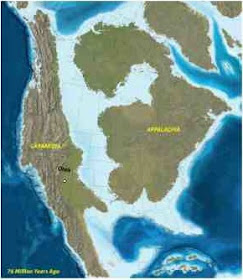Tyrannosaurids were large, predatory Dinosaurs from the Late Cretaceous of North America and Eurasia. They are among the best known of all Dinosaurs, since they were the biggest carnivores in their ecosystems, making them (particularly the eponymous Tyrannosaurus rex at 13 m and up to 6.8 tonnes) a must have for any Hollywood movie featuring Dinosaurs. The group has been extensively studied, with a fairly large number of well preserved specimens known, making it possible to assign fragmentary remains and even individual bones to the group with some confidence.
Movie depictions of Tyrannosaurids like this one have made them one of the best known (and best loved) groups of Dinosaurs. King Kong/Peter Jackson/Universal Pictures.
In a paper published in the journal Acta Palaeontologica Polonica on 22 August 2012, a team of scientists led by Brandon Peecook of the Department of Biology and Burke Museum of Natural History and Culture at the University of Washington discus the discovery of a metatarsal (foot bone) of a Tyrannosaurid Dinosaur in the Late Cretaceous 'El Gallo' Formation of Baja California.
The left fourth metatarsal (red) on a human. Modified from The Florida Center for Instructional Technology.
The specimen is a left fourth metatarsal 391 mm in length. It has a deep notch on its articular surface and a concave posterior surface, features that were used to diagnose the bone as having come from a Tyrannosaur. This is not, however, enough information to make any more specific diagnosis, though the bone is small for a Tyrannosaur metatarsal, suggesting it may have come from a juvenile animal.
The 'El Gallo' Tyrannosaurid metatarsal. Peecook et al. (2012).
The bone comes from the El Disecado Member of the ‘El Gallo’ Formation, making it between 75.21 and 74.55 million years old (the 'El Gallo' Formation is placed in inverted commas because the name is not official, it derives from an unpublished Ph.D dissertation from 1963, and has entered popular usage, but the formation has never been formally described).
This is the first Tyrannosaurid described from Baja California. During the Cretaceous North America was divided in two by a vast inland sea, the Western Interior Seaway. The landmass to the east of this is called Appalachia, that from the west (of which Baja California forms a part) is called Laramidia. Tyrannosaurs are known from Laramidia, but only from the east and northeast of the island. Baja California, on the southern Pacific Coast of Laramidia, therefore represents an extension of the known range of Tyranosaurid Dinosaurs.
See also Police seize Dinosaur from New York warehouse, A giant feathered dinosaur from the Early Cretaceous of Liaoning Province, China, The bite of T. rex, A review of Jurassic Tyrannosauriods leads to the description of a new genus and Dinosaurs on Sciency thoughts YouTube.
Follow Sciency Thoughts on Facebook.




